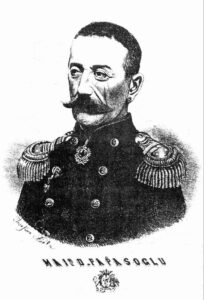Dr. Roxana Coman (Orient-Institut Istanbul PostDoc Researcher)
There and back again: Ottoman Imperial legacies and Dimitrie Papazoglu’s collection of Ottoman artefacts

Josefine Bielz, Dimitrie Papasoglu, lithograph, edited by D. Papazoglu, Editura D. Pappasoglu, image source: Istoria fondării oraşului Bucureşti; Istoria începutului oraşului Bucureşti; Călăuza sau conducătorul Bucureștiului, București: Fundaţia Culturală “Gheorghe Marin Speteanu”, 2000
Dr. Roxana Coman is a researcher working on the topic of Ottoman material culture and private 19th and early 20th century collections in Romania. After graduating from a BA and MA in Art History in the Faculty of History, University of Bucharest, she explored in her PhD the various narratives and representations on what was constructed as Oriental vs Romanian during the second half of the 19th century by using a diversity of sources. Volunteering during her BA and MA studies in the National Museum of Art of Romania, she worked between 2016 and 2022 as a curator and museum educator in the Bucharest Municipality Museum.
After obtaining her PhD in 2016, Roxana continued to research the dynamic between the presence of Ottoman material culture in Wallachia and Moldavia, and the national state of Romania strategies to deal with its Ottoman legacy. Therefore, she attended several summer schools such as Transregional Academy “Shadows of the Empires. Imperial Legacies and Mythologies in Central Eastern Europe”, 14-21 September 2021 in Sofia, Bulgaria, and The City as Archive. Histories of Collecting and Archiving in and the Musealisation of Florence, Eighteenth Century to the Present, 18-25 September 2018. She is currently a PostDoc fellow at the Orient-Institut and a member of the COST Action EuroWeb: Europe through Textiles: Network for an integrated and interdisciplinary Humanities. Her post-doctoral research project focuses on Dimitri Papazoglu’s extraordinary collection of Ottoman artifacts.
In 1860, Dimitrie Papazoglu (1811-1892) opened a museum in his private residence on Calea Văcărești, no 151, Bucharest. His collection of „antiquities and rarities”, as he called it, gathered over 40 years was at the core of this private museum. Having received formal education in the Habsburg imperial school in Brașov, he retired from the army in 1833. Afterwards, Papazoglu begins dabbling in archaeology and history writing, Alexandru Odobescu’s archaeological campaigns in Romania acting as both a learning environment, and as a source for a part of his collection.
The analysis will focus on the Ottoman/ Oriental artefacts whose occurrence in the collection questions their assigned interpretations by Papazoglu. Moreover, the ambivalent Romanian nationalist discourse pendulating between a systematic discourse of rejection of the Ottoman heritage and an exoticist type of representation challenges a mere aesthetic approach and opens a discussion on issues such as identities in late Ottoman Empire and the creation of a national concept of heritage. Therefore, the project aims to map existent archival records concerning Dimitrie Papazoglu’s biography and collection, and explore the center-periphery dynamic on the issue of history of collections in the 19th century Ottoman Empire.
